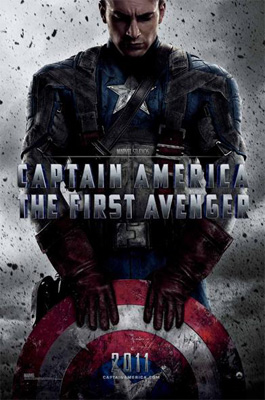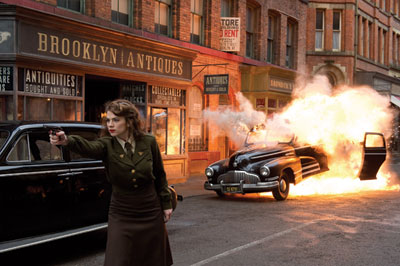Captain America: The First Avenger World War II, Marvel-Style

Captain America: The First Avenger
Cast: Samuel L. Jackson, Hugo Weaving, Chris Evans, Sebastian StanDirector: Joe Johnston
Genre: Action, Adventure
Synopsis: Captain America: The First Avenger will be a rousing action/adventure epic in the best of the Marvel movie tradition. It's the story of Steve Rogers, a shy young man given incredible powers that must be used to turn the tide of history and save the world. He longs to serve his country in the fight to stop evil. However, his frail body leaves him unfit to join the military. A brilliant scientist offers a chance to participate in an experimental program which turns Steve into the enhanced Super Soldier known as Captain America.
Release Date: 28th July, 2011
Website: www.captainamericamovie.com.au
World War II, Marvel-Style
Filmed for the most part in the UK, production of "Captain America: The First Avenger" was based at the world-famous Shepperton Studios in Surrey (or 'Sound City,' as it was known when productions began shooting there in 1931, a decade before the world was introduced to Captain America). Principal photography began on July 12, 2010 and officially wrapped on November 19, 2010-the shoot employed somewhere in the region of 1,000 crew members.
Soundstage shooting was augmented with plentiful location work: in Manchester and Liverpool (North England), Caerwent (Wales, in a former functioning Royal Navy propellant factory), Aldershot (known as 'Home of the British Army'), Black Park (Buckinghamshire), Hackney Empire (London) and Pinewood Studios (Buckinghamshire).
Even though filmmakers were aiming for the Marvel version of the 1940s, care was taken to keep it grounded in reality. Co-Producer Victoria Alonso says, "We always have a compilation of what was historically accurate, and then we augment as necessary to fit our story."
Production designer Rick Heinrichs was painstaking in his depiction of locations and history, adapting the British locations into the American settings called for through both practical and computer alterations and additions. Anna Sheppard, who costumed upwards of 300 extras a day for certain scenes, looked to period materials and existing pieces to lend authenticity. Military advisor Billy Budd-with more than 15 years in the British Royal Marines-aided all actors with advice in how to handle military equipment and weaponry; the filmmakers also incorporated actual military personnel in heavy action scenes, with actual or former soldiers comprising about one-third of the on-screen corps. (Billy Budd admits to withholding advice for Evans during his pre-Captain America scenes: "I didn't want him to have any inkling how to do anything the military way, even come to attention-so he authentically fumbles through a lot of stuff before he becomes the hero he's meant to be.") Supervising production armorer Nick Jeffries researched and procured appropriate period guns and instructed actors in their safety and firing. Stunt coordinator Steve Dent also ensured on-set safety during sequences, and helped to create Captain America's amazing feats of physical prowess, including his high-speed foot chase immediately after his transformation (accomplished with Chris Evans being filmed running while on a 'magic carpet,' a treadmill/floor moving at a fair clip).
Training was not exclusive to the male soldiers in the film. Hayley Atwell underwent rigorous military circuit training with an ex-Marine, not only for physical preparedness, but also to handle firing both a pistol and a machine gun believably as Peggy Carter: "The pistol training, I use a Walther PPK, happened quite early on. I'd practiced with a gun before, but nothing ever on this scale. I was really looking forward to it and we filmed some of my training sessions. Then Joe Johnston, the director, who always liked to have a bit of fun and then see it if he could push it a bit further, said, 'What if we got you a machine gun? I really think we should make Peggy Carter something special.' So they brought out this machine gun, and I almost fell over the first time I fired it-it's so in your face, and there are bits of shells and powder going everywhere, and giving off all this heat. I wondered how I was ever going to do it without flinching. It took a few weeks of being able to fire it without blinking, just concentrating and being able to relax into it. Eventually I was able to feel like it was an extension of my arm. I have to say, in the end, I was rather pleased with myself-but so was Joe Johnston, and that meant a lot."
 While most of the cast and crew readied themselves to simulate World War II combat, others were tasked with making Steve Rogers look less ready for war. Visual effects supervisor Christopher Townsend was tasked with creating the look of Steve Rogers prior to his transformation. With previous work in fantasy, action and adventure, Christopher Townsend came armed and ready for the tasks at hand. Christopher Townsend also admits being sold on the job by having been a huge fan of Marvel's cinematic treatment of "Iron Man." He admits, "I truly enjoyed the film and quite frankly, it excited me to think what we could do with 'Captain America,' especially getting to work on an origin movie and setting the tone for what he's going to be, what the character's going to look like and be able to do."
While most of the cast and crew readied themselves to simulate World War II combat, others were tasked with making Steve Rogers look less ready for war. Visual effects supervisor Christopher Townsend was tasked with creating the look of Steve Rogers prior to his transformation. With previous work in fantasy, action and adventure, Christopher Townsend came armed and ready for the tasks at hand. Christopher Townsend also admits being sold on the job by having been a huge fan of Marvel's cinematic treatment of "Iron Man." He admits, "I truly enjoyed the film and quite frankly, it excited me to think what we could do with 'Captain America,' especially getting to work on an origin movie and setting the tone for what he's going to be, what the character's going to look like and be able to do." To convert Chris Evans to the 98-pound Steve Rogers, Christopher Townsend employed a collection of visual effects techniques, including head replacement, which was made more believable by 'thinning' both Chris Evan's head and face. A slimmer body double would watch Chris Evans film the scene, then mimic Chris Evans' performance as closely as possible. Then head and body were married by Christopher Townsend's final magic. Even at 5'7", the double didn't always appear ineffectual enough, so software was employed to waste his body somewhat. "Chris Evans has such a phenomenal physique, it seems almost a crime to do that to him," says Executive Producer Louis D'Esposito, "But you're going to be shocked to see the results and how the visual effect compliments his performance."
All during filming, Joe Johnston's name was bandied about on-set as being an 'actors' director,' which Chris Evans explains: "Joe Johnston loves hearing what the actors have to say and he's always willing to rehearse and talk about scenes. He sits everyone down to have really healthy, collaborative, creative conversations, and you don't always have that luxury. He also shields you from the hierarchy of who need to give their approval on the most minute detail-you really feel like it's just you and him and that you're making an indie film together. Whatever the situation, he'll make it work and he'll fix it-and on a film with this much scale, that is massively comforting."
MORE



